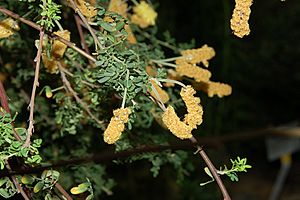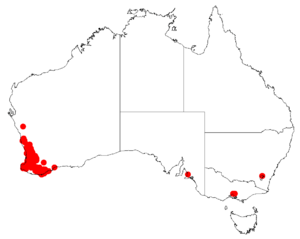Drummond's wattle facts for kids
Quick facts for kids Drummond's wattle |
|
|---|---|
 |
|
| Scientific classification | |
| Genus: |
Acacia
|
| Species: |
drummondii
|
 |
|
| Occurrence data from AVH | |
| Synonyms | |
|
Acacia drummondii var. typica E.Pritz |
|
Acacia drummondii, also known as Drummond's wattle, is a type of shrub that grows year after year. It is found only in Western Australia.
Contents
What Does Drummond's Wattle Look Like?
This plant is a straight and bushy shrub. It usually grows between 0.3 and 1.8 meters (1 to 6 feet) tall. It can also spread out to be about the same width.
Its branches are thin and have a reddish color. They often grow close to the ground. The leaves are a pretty mid-green to slightly bluish-green color. They stand upright from the stem and are divided into sections, but they are not feathery. Each leaf is about 2.5 centimeters (1 inch) long.
Flowers and Blooming Time
Drummond's wattle blooms from June to October. It produces bright yellow flowers. These flowers grow in spikes, with one spike forming where each leaf meets the stem. The flower spikes are about 2 to 4 centimeters (1 to 1.5 inches) long. They look soft and have a clear, bright yellow color, but they don't have a scent.
Who Named Drummond's Wattle?
The first official description of this plant was made by a botanist named John Lindley. He described it in 1839 in his book about plants in the Swan River Colony.
Later, in 2003, another botanist named Leslie Pedley reclassified it. He called it Racosperma drummondii. However, in 2006, it was moved back to the Acacia group.
The plant's name, drummondii, honors James Drummond. He was a government naturalist in the Swan River Colony, which is now part of Western Australia.
Where Does Drummond's Wattle Grow?
Drummond's wattle grows in different areas of Western Australia. You can find it stretching north from the Wheatbelt region. It also grows south to the Great Southern region, near a city called Albany.
It likes to grow in various places. This includes rocky areas like granite outcrops, in low-lying gullies, and on hillsides. It grows well in sandy and gravelly soils, often near a type of soil called laterite. You can often see it growing as a smaller plant under the taller trees in forests and woodlands.

